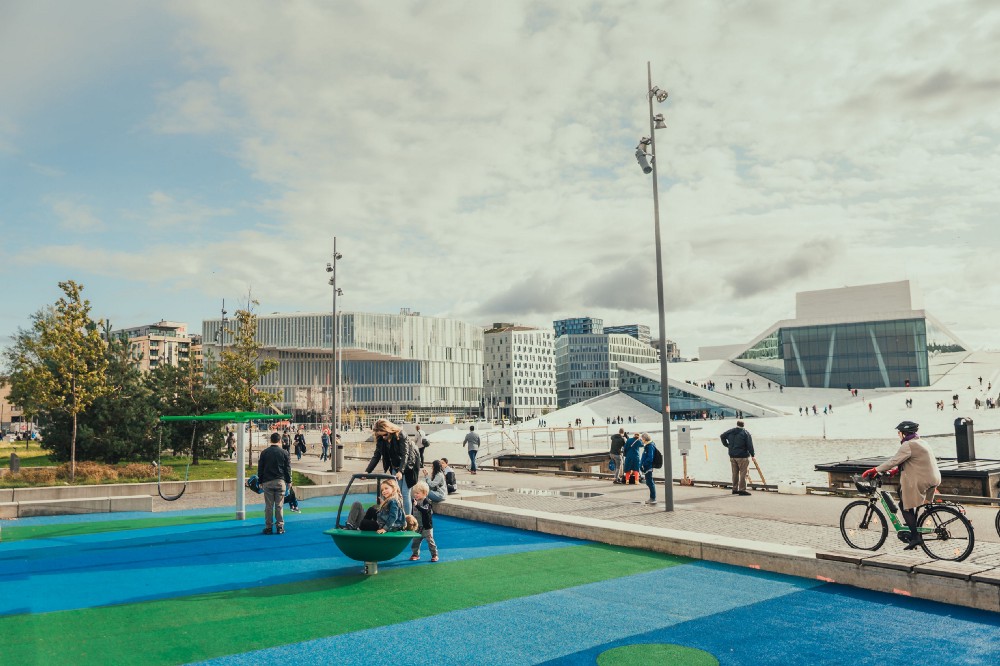This article will appear in Transportation Alternatives’ Vision Zero Cities Journal as part of the 2020 Vision Zero Cities Conference, Oct. 19-23. You can still register for the conference at visionzerocities.org.
Putting people first makes cities work better for everyone. It is not an easy task, but Oslo, the capital of Norway, has done important work to show that it is possible. In 2019, Oslo achieved Vision Zero. Reaching that goal was bigger than just saving lives — Oslo had to build a happy, healthy, attractive city.
While disagreement and conflict are a part of the story, there is also a lot of common ground to be found. Working together is the only way to make that a Vision Zero a reality.
Make The streets where you meet people
“Our main objective is to give the streets back to the people,” Hanna Marcussen, Oslo’s Vice Mayor for Urban Development told BBC Future in 2019, explaining the radical changes the city was making to local streets.
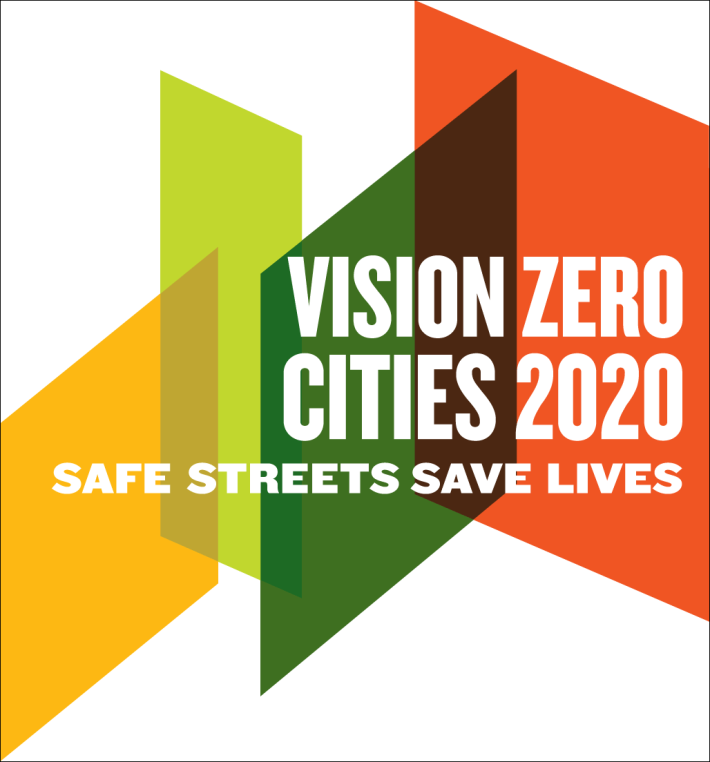
Marcussen’s point was that, until recently, the people of Oslo did not have a say in what the streets of Oslo were used for — and that needed to change. She saw the potential for the streets to be places where Norwegians met one another, ate in outdoor restaurants, where kids could play, and where art could be exhibited.
She also knew that none of this worked without reaching Vision Zero.
To reach these goals, Oslo began closing off streets in the city center to cars entirely. The city removed all 760 on-street parking spots inside the city’s inner ring road. And in place of all that, the city installed cycling lanes, benches, and miniature parks. This radical reimagining of public space did not come to pass over night. In fact, it began decades ago.
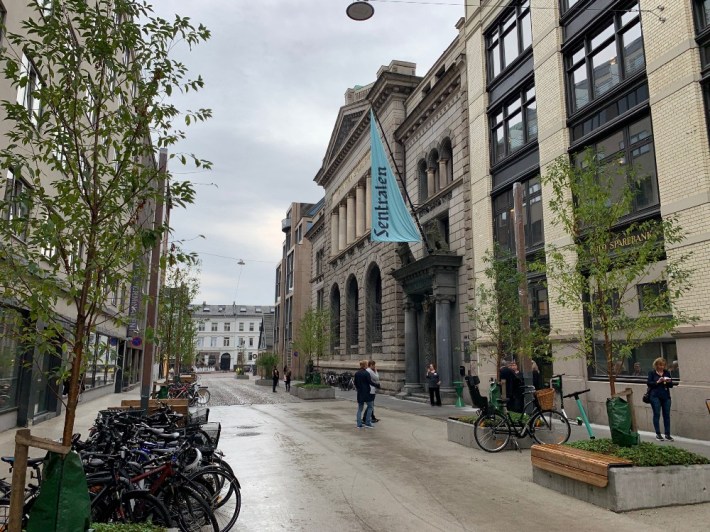
The history of Oslo streets
The idea of making Oslo more livable — reducing the role of private cars in the city at the same time as adding infrastructure for people — evolved over time.
The story begins in 1990, when Oslo decided that cars were not good for the city. While, at this point, car-use was not restricted, an important change in priorities was made. The main road system in Oslo was moved away from the surface and down into tunnels below the city center. This dramatically reduced the number of cars visible on Oslo roads at any given time.
By 2014, these ideas had advanced. That year, the Danish architect Jan Gehl conducted a survey on public life in Oslo. The survey identified several challenges: There was little activity after office hours. Traffic was heavy. Public spaces were not nice. There was a lack of basic infrastructure like public benches and drinking fountains, and a lack of green space.
Gehl’s findings resulted in two steps which would be crucial to Oslo reaching Vision Zero and for the long-term development of a people-oriented city. One was a plan to increase city life by addressing the challenges identified in Gehl’s survey. The other was a legally-binding zoning plan for the streets and urban spaces in the city center. The rezoning gave a green light to the strategies laid out in the plan to increase city life.
The following year, an important conversation began about the city’s future. Knowing that Oslo is expected to see an almost 30 percent increase in population by 2040, the Norwegian capital began to worry about its carbon footprint. In 2016, effectuated a climate and energy strategy targeting to reduce Oslo’s direct greenhouse gas emissions by 50 percent by 2022 and to be reduced to zero by 2050. By 2017, the City of Oslo was able to launch a response to these concerns — reducing all traffic in Oslo and to give the city center more car-free areas and car-free streets. The Car-free Livability Program set a clear goal was to make the Oslo city center greener and more inclusive for everyone.
Vision Zero is at the intersection of reducing Oslo’s carbon footprint, and increasing city life. The only joint answer to these goals is to make the city center car-free. While efforts to reduce car traffic have been effectuated gradually, the plans are bold: the removal of 760 on-street parking places, a new driving pattern to prevent through-traffic, reallocating of car-free areas for new uses to increase city life. The first actions took place in six pilot areas the summer of 2017, when the first 350 parking spaces were removed. In 2018, further removal of parking spaces was implemented, as well as effectuating the changes in driving patterns in and to the city center.
The aim of the Car-free Livability Program in Oslo is to improve the city environment and increase city life within the inner ring road, using car-free zones as a tool. Fewer than 1,000 people are living in the area, but more than 100,000 travel in and out to work everyday. When launched, the extent of the car-free area was considerably larger than other car-free city centers in Europe. These efforts have inspired the nation, and In Norway today, both national, county, and municipal plans have stated objectives of zero-growth in traffic volumes or reductions in total traffic volumes.
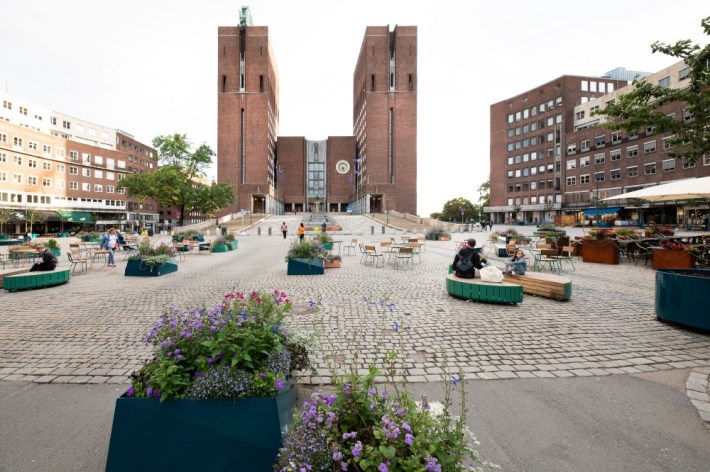
How to change the street
Looking back at Gehl’s survey from 2014, one of the key findings was the lack of city life in the streets between Karl Johan’s Gate, the Oslo Parade Street, and the Fjord. This is why the Car-free Livability Program is focused on working strategically to bring positive change in these north-south axes of the city. Over the course of four years, Oslo has tested a range of measures both big and small, temporary and permanent.
Physical measures have been important in transforming the city’s urban spaces. Oslo has opened a number of new pedestrian streets and upgraded one street to a mixed-use street, where two thirds of the street space is car-free, reserved for people walking and other city life. The city has built new benches and drinking water fountains throughout the city center. Playgrounds for children and families have been opened citywide. To make these spaces inviting at all hours, both permanent and seasonal lighting has been installed. These are just a few of the measures that have been implemented.
What unites them all is in direct response to Gehl’s survey and Oslo’s climate goals. By turning the traditional planning pyramid upside down — putting people’s needs at the top and private cars at the bottom — Oslo has managed to prioritize pedestrians, bikes, and city life in streets and squares that were formerly dominated by private cars.
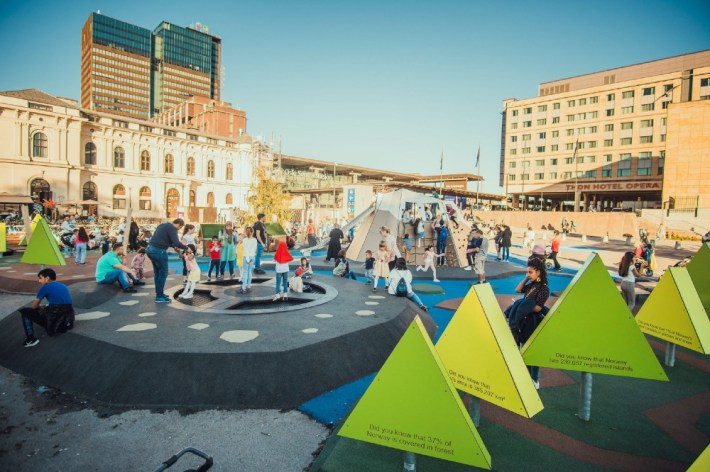
How to work together
Co-creation has been a critical part of the Car-free Livability Program. The radical changes in Oslo is also the story of doing things differently, and part of this was involving private interests in the design process.
It is no secret that Oslo also has faced challenges in regard to opposition against our plans for a car-free city. Both when the initiative was first announced and when the first major interventions arrived, Oslo’s leaders were met with considerable protest. Stakeholders, such as shop owners and trade associations, feared the consequences on customer access to shops in the city center. To address these concerns, from the beginning, NGOs and companies invested in Oslo’s city center have been involved in the physical design, upgrading and conversion of city streets. To get the buy-in of these partners, piloting changes has been an important tool in the program.
At the same time, we have also seen how the efforts of the city inspired and promoted innovations within the private sector. In Oslo, we have seen many examples of companies that are placing focus on environmentally-friendly and health-promoting forms of mobility. A rather good example is the carpentry firm Lohne & Lauritzen, which has replaced several of their diesel trucks with electric bikes. The company reports that their employees can now get around more quickly, that absenteeism due to illness has gone down by 30 percent and their bicycle initiative has boosted their reputation and helped bring in more work. The goods-delivery sector has also undergone huge changes since efforts to increase city life began. Major companies such as Bring, DHL, and Schenker have begun using new loading centers and shipping more and more goods by electric bikes all year round.
As driving a car in Oslo has become less attractive, the city also prioritized the importance of ensuring city logistics and accessibility to properties, and the need to continuously improve access to the city center for marginalized groups, like people with disabilities.
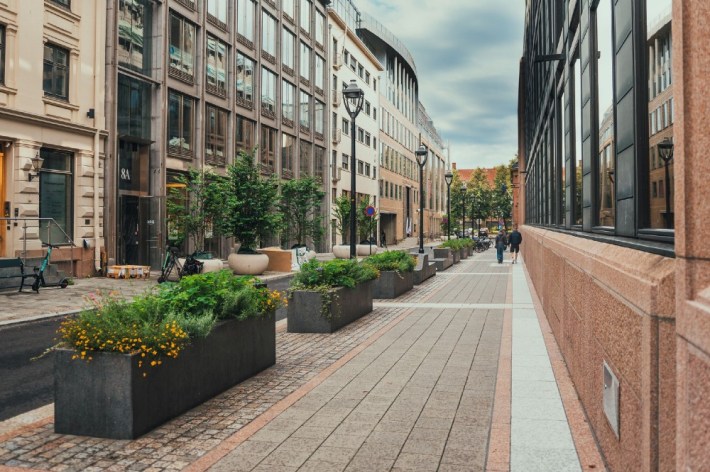
Vision Zero is possible
Even though traffic reduction and safety for pedestrians was not the primary goal of the Car-Free Livability Program in Oslo, the Norwegian capital reached a milestone in 2019: Zero pedestrian and cyclist fatalities in the city center.
This is the result of long-term work. Back in 1975, there were 41 traffic deaths. A decade later, the number dropped to 27, and by 1990, the number was 18. For these positive developments, before the Car-Free Livability Program, we will have to point to a variety of solutions and a continued focus on improvements: increased bike infrastructure, lower speed limits, fewer cars on the road overall, less traffic in residential areas, speed bumps, better technology in the cars.
But for the last few years, what made the leap from 18 killed to zero, has been Oslo’s promotion of car-free areas and encouraging people to shift their habits when speaking of traveling into the city. In May, the Agency for Urban Environment released the numbers from their latest traffic counting in Oslo: 28 percent of cars disappeared from the city center between 2016 and 2019. While it is impossible to quantify how much of the decrease in car traffic is due to any one measure, there is a high likelihood that the Car-free Livability Program contributed greatly.
It is not a secret that it is now increasingly more difficult to bring your car into the city, and especially park your car in the city. This has done more than bring life to the city center, it has saved lives.
What is next?
Today, Oslo is working on how to reduce car traffic even more in order to create an increasingly pleasant and people-friendly city center. The plan is also being replicated in nearby suburbs — Tøyen and Gronland — which would also benefit from more city life.
As with all else, COVID-19 has also had an effect. When Norwegians met the reality of the COVID-19 virus, we saw changes in transportation patterns, including a 32 percent decrease in traffic in March alone. A survey in May found that Norwegians want to change their travel habits permanently. One in five who took public transport to and from work no longer do, and 15 percent plan to change their travel habits permanently when the corona crisis is over.
However, thanks to the work that Oslo has been doing for decades to increase and improve city life, unlike other cities that have seen an increase in driving during COVID-19, more than half of Norwegians surveyed said they intend to walk and cycle more than before.
Terje Elvsaas is the former communications adviser for the Oslo Car-free Livability Program. He is now a communication adviser and press officer at the consultancy company Ramboll Norway.
